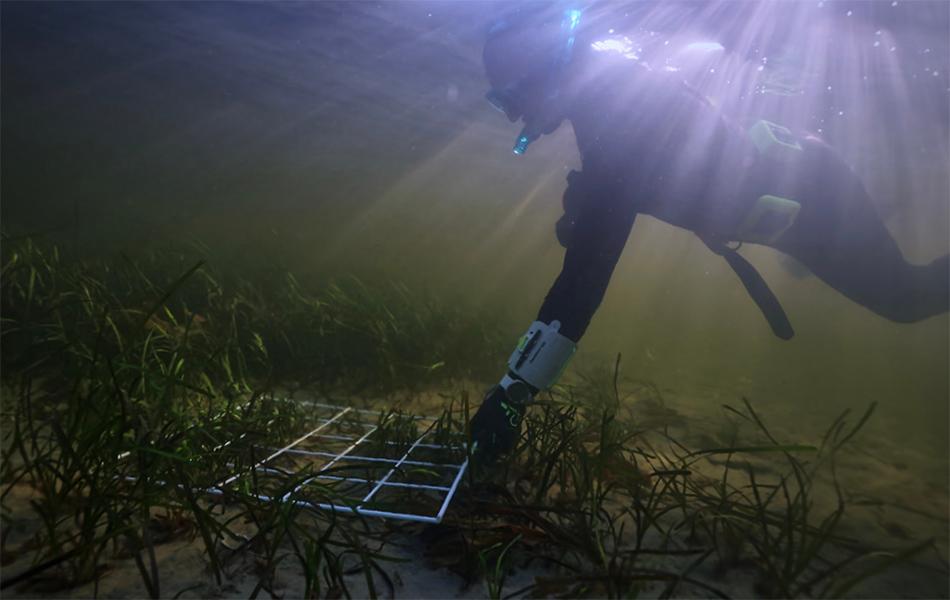
Karen Boswarva looks at the toll of winter storms, and how they impact marine communities.
Have you noticed that storms and the increase in severity and frequency of storm events have been causing us no end of problems lately? Disrupting travel, damaging our houses, rooting up trees, and even worse, blowing out our winter diving and snorkelling trips! Terrible.
Well, what if I told you that storms have a similar effect underwater too!
Love or hate them, the winter and spring storm season is super important to marine ecosystems. During summer, we feel the change in temperature as we dive down, breaking through an invisible barrier known as a thermocline. In winter, increased turbulence in our coastal waters breaks down the thermocline, mixing shallow warmer water with deeper nutrient rich colder water and sediments. This process carries nutrients back up to the surface, and back into the food chain, where they can be eaten by a whole host of animals. This also drives a second, smaller season of phytoplankton bloom.
Storms will move sediment more readily and reshape the seabed. Important habitat forming species such as Sabellaria spinulosa (Ross worm) may even need storm events to fulfil aspects of their lifecycle. As shifting sands blow over their reef structures, it forms a temporary blanket and appears to trigger a growth spurt in reef building activity. Pretty cool.
Other examples can be seen on the shoreline. Storms rip up kelp and seaweed, bringing it to shore en-masse. Tangles of kelp stipes intertwined with wrack [a type of seaweed] litter the strandline, and for the intertidal zone and the species that rely on it, the sea has just provided a gourmet banquet fit for a king crab!
But storms can have a detrimental impact on species too. There’s an imbalance caused by an increase in unsettled and severe weather events, especially when coupled with sudden rapid drops in air temperature; those sudden cold snaps that nip at your fingers and make the dive warmer than the shore part.
In temperate seas, an increase in storm frequency may cause a greater quantity of kelp to wash ashore
The Beast from the East is one such weather phenomenon which is becoming increasingly more common. Polar continental air masses (cold and dry air) from the east are drawn towards the UK, bringing some of our coldest weather. It also causes a sudden sharp drop in sea temperature. You may have seen the reports - mass strandings, mostly of starfish, crabs and lobsters? The sudden temperature change effectively stuns the animals, reducing activity level and increasing their vulnerability to dislodgement in rough winter seas. For some warmer species, the sea temperature falls to their lowest tolerance limits, then they struggle to survive until the sea warms up again.
Then add in an increase in storm frequency, which affects hydrodynamic tolerance (an organism’s ability to withstand the force of moving water). In temperate seas, an increase in storm frequency may cause a greater quantity of kelp to wash ashore, reducing the biomass of attached (alive) kelp and canopy cover, thus removing vital habitat. In equatorial seas, an increase in the frequency and severity of tropical cyclones can degrade coral reefs and alter the diversity and abundance of organisms within the sediment.
To end on a positive note, storms promote annual regeneration and growth. A storm will often reveal the ocean’s deepest treasures. For anyone who enjoys a good storm-day walk on the beach, look to the strandline at the abundance of life that has washed ashore. Dig amongst the kelp and fondle the seaweeds. You may find anything from a deep-sea leviathan swept up from the depths, a host of ocean wanderers aboard their flotsam carriage, to stowaways flung out from far off shores. When in balance, storms are a stunning and vital aspect of the seasonal cycle – something to admire.
Article ‘Stormy weather by Karen Boswarva first published in SCUBA magazine, Issue 154 April 2025.

 Author: Karen Boswarva | Posted 07 May 2025
Author: Karen Boswarva | Posted 07 May 2025



